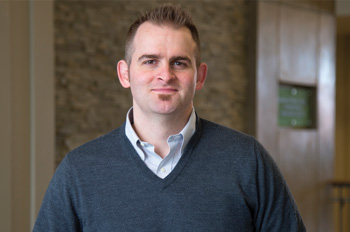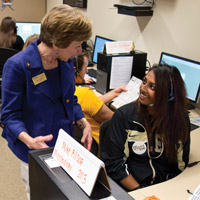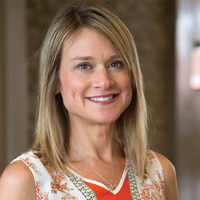
Emerging Researcher Photo by Mark Simons
In March 2014, the Centers for Disease Control and Prevention reported the highest incidence of autism in U.S. history, citing that one in 68 children nationally — one in 42 boys, and one in 189 girls — has the disorder.
The very name autism spectrum disorder (ASD), which is associated with myriad weaknesses and strengths, speaks to the challenge it presents to those trying to understand it. Those at one end of the spectrum can be described as very high functioning — even brilliant about specific things — while those at the other end can have significant difficulty communicating and assimilating into society. Despite such differences, individuals along the spectrum share one ASD label.
An autism cartographer of sorts, Brandon Keehn has embraced the challenge. He studies and maps the brain activity of infants and children, charting differences that distinguish ASD brain activity from that of typically developing children. Keehn began working to understand ASD as an undergraduate at the University of Washington and continued his work as a graduate student at the University of California, San Diego, and as postdoctoral fellow at Boston Children's Hospital and Harvard Medical School. He joined the Purdue faculty in 2014 as an assistant professor of speech, language, and hearing sciences and psychological sciences.
"What attracted me to the study of autism most is that, as an undergrad working with children in the lab, I saw how each kid was just so different," Keehn says. "I wanted to understand what linked all of them together."
Most recently, Keehn published a study in Autism Research focusing on how brain responses to faces reveal disparities between infants at high risk for autism — those with an older sibling with ASD — and low-risk infants with no family history of ASD. His findings build on earlier research showing that those with ASD have deficits in a skill needed for social interaction — processing people's faces.
He found that the brains of high-risk infants, when tested at six months and again at 12 months, show increasing brain-network activity in the left hemisphere during face processing, when such brain activity in the low-risk, typically developing infants' brains happened where it was expected, in the right hemisphere.
"Our study can't say why high-risk infants develop face-processing impairments," Keehn says. "But we did show that these impairments emerge over the first year of life and are associated with atypical connectivity of the network responsible for face processing."
Infants at risk for ASD, particularly those who receive a later diagnosis, showed the greatest atypical lateralization of the face-processing network, he says. The next step is to investigate whether there are genes that can be mapped to this atypical brain specialization, which could be used as a marker for potential early diagnosis.
Keehn also is studying superior abilities among those with ASD. Some children on the spectrum, for example, have been shown to excel at finding objects hidden within a number of distracting items.
"If we understand the mechanism for this better performance, that may be important for understanding how the brain develops differently in children with ASD," he says.











